Notebook of Gerard Henderson Cowan - Part 1
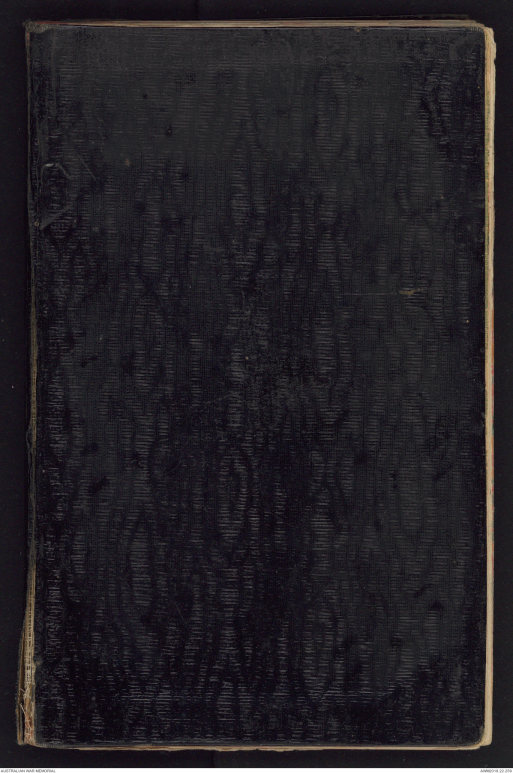
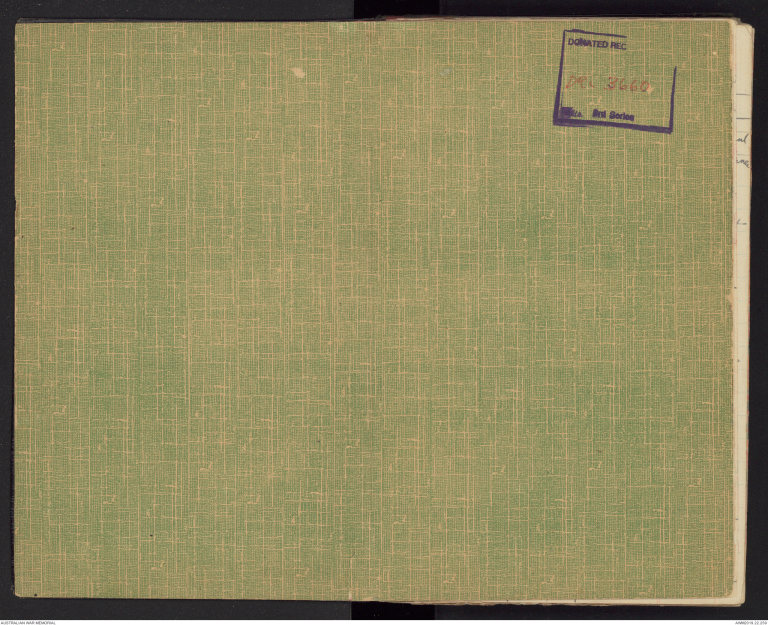
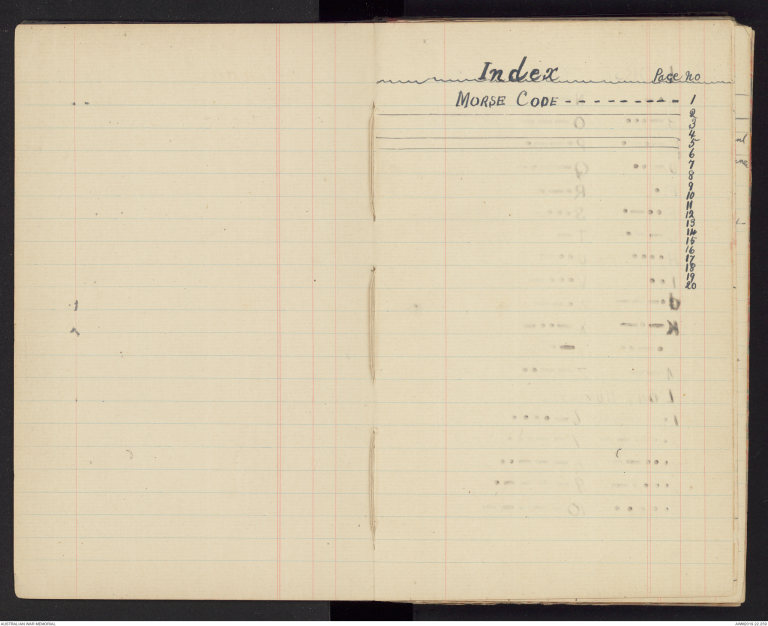
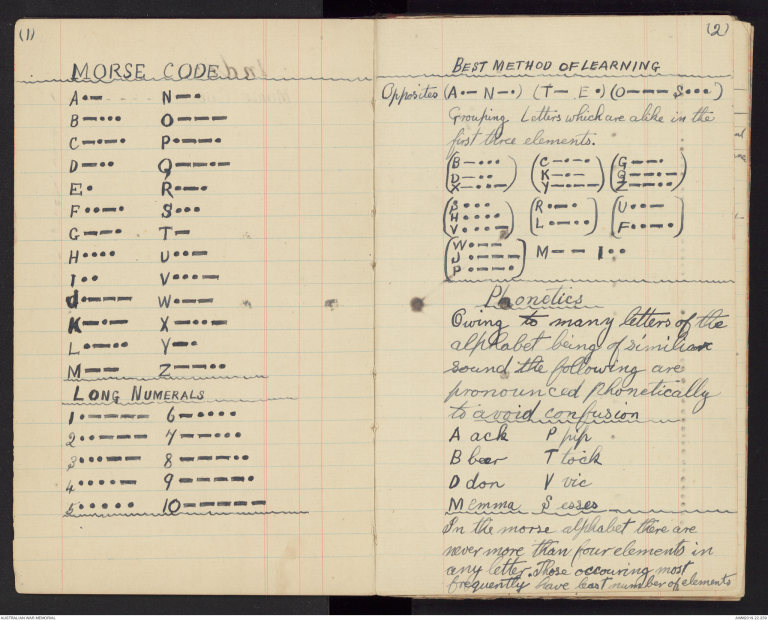
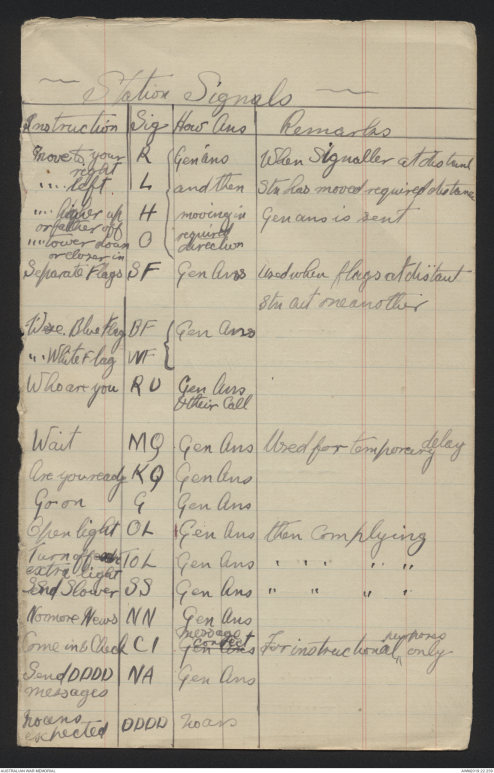
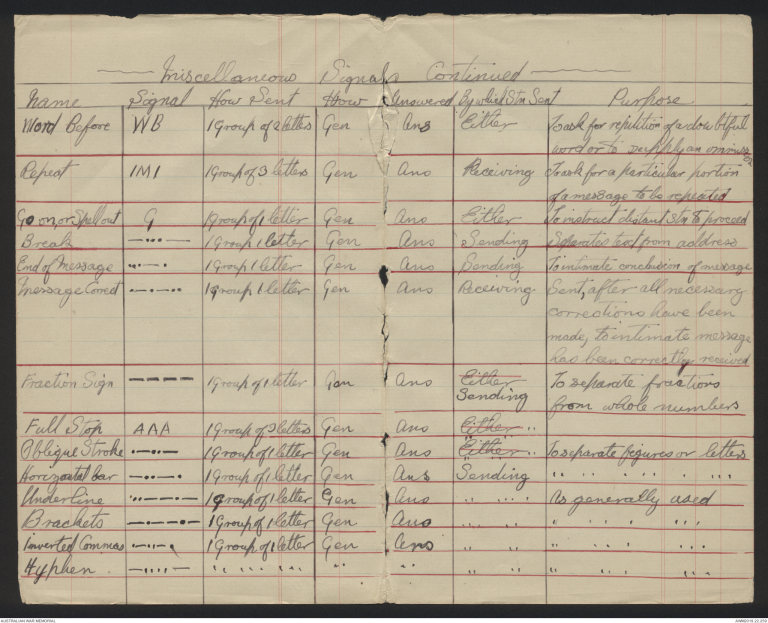
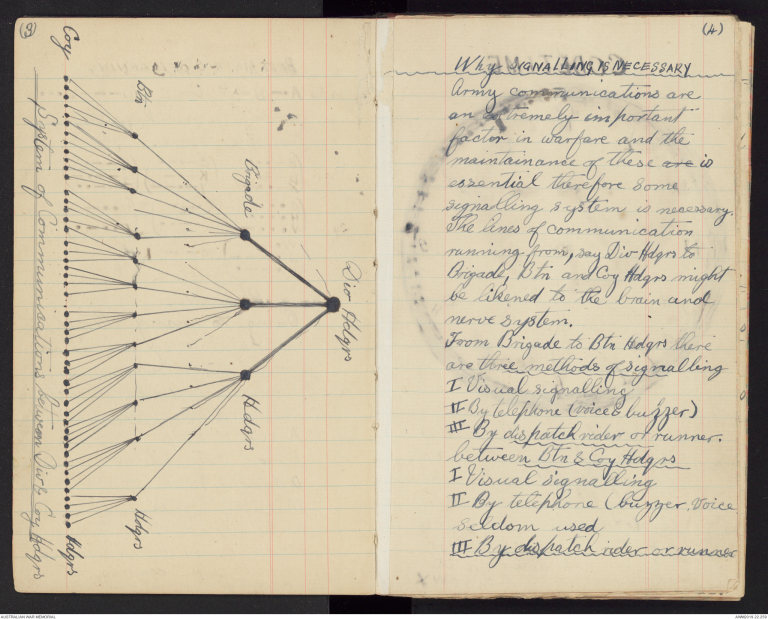
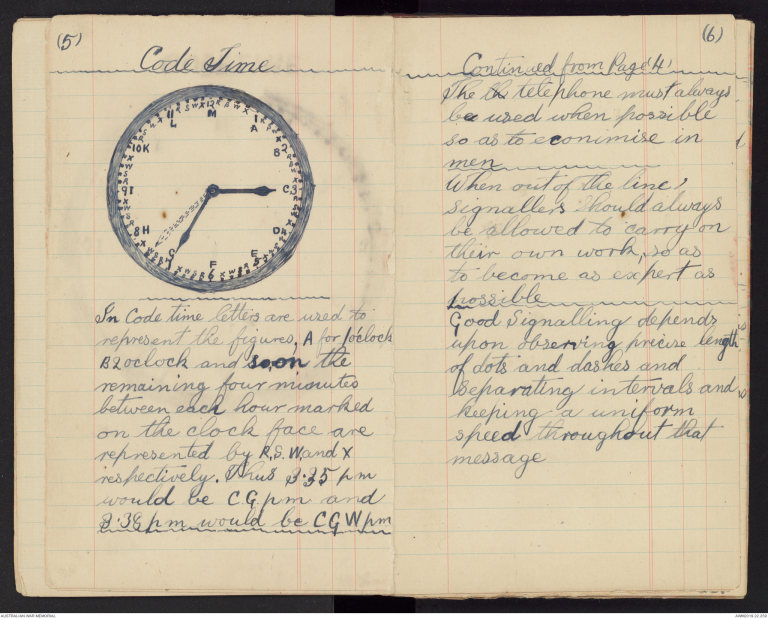
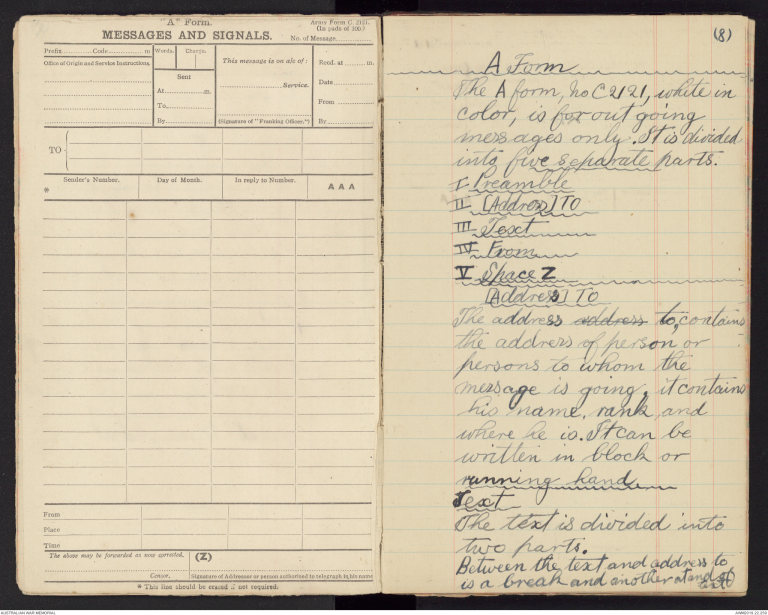
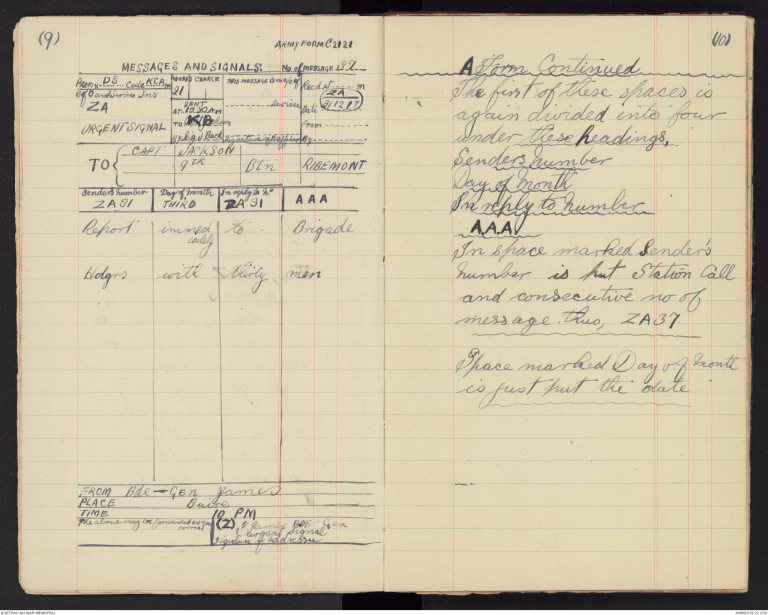
| Index | Page No |
| MORSE CODE --------- |
1 |
|
2 |
|
|
3 |
|
|
4 |
|
|
5 |
|
|
6 |
|
|
7 |
|
|
8 |
|
|
9 |
|
|
10 |
|
|
11 |
|
|
12 |
|
|
13 |
|
|
14 |
|
|
15 |
|
|
16 |
|
|
17 |
|
|
18 |
|
|
19 |
|
|
20 |
(1)
MORSE CODE
| A .- | N -. |
| B -... | O --- |
| C -.-. | P .--. |
| D -.. | Q --.- |
| E . | R .-. |
| F..-. | S ... |
| G --. | T - |
| H .... | U ..- |
| I .. | V ...- |
| J .--- | W .-- |
| K-.- | X -..- |
| L .-.. | Y-. |
| M-- | Z--.. |
Long Numerals
| 1 .---- | 6 -.... |
| 2..--- | 7 --... |
| 3 ...-- | 8---.. |
| 4....-- | ----. |
| 5 ..... | 10 ----- |
(2)
BEST METHOD OF LEARNING
Opposites (A .- N -.) (T - E .) (O --- S ...)
Grouping Letters which are alike in the
first three elements.
| (B -...) (D -..) (X-..-) |
(C -.-.) (K -.-) (Y -.--) |
(G --.) (Q --.-) (Z --.-) |
| (S ...) (H ....) (V...-) |
(R.-.) (L .-..) |
(U ..-) (F.._.) |
| (W .--) (J.---) (P .--.) |
M -- |
I .. |
Phonetics
Owing to many letters of the
alphabet being of similar
sound the following are
pronounced phonetically
to avoid confusion
A ack P pip
B beer T tock
D don V vic
M emma S esses
------------------------------
In the morse alphabet there are
never more than four elements in
any letter. Those occouring most
frequently have part number of elements
Station Signals
| Instruction | Sig | How Ans | Remarks |
| Move to your right | R | (Gen ans | When signaller at distant |
| " " " left | L | (and then | stn has moved required distance |
| " higher up or farther off |
H | (moving in | Gen ans is sent |
| " lower down or closer in |
O | (required (direction |
|
| Separate Flags | SF | Gen Ans | Used when flags at distant |
| [[?]] Blue Flag | BF | (Gen Ans | stn act one another |
| " White Flag | WF | ( | |
| Who are you | RO | Gen Ans & their call |
|
| Wait | MQ | Gen Ans | Used for temporary delay |
| Are you ready | KQ | Gen Ans | |
| Go on | G | Gen Ans | |
| OPen light | OL | Gen Ans | then complying |
| Turn off extra light |
TOL | Gen Ans | " " " " |
| Send Slower | SS | Gen Ans | " " " " |
| Nomore News | NN | Gen Ans | |
| Come into Check | CI | Message Correct |
For instructional ^ purposes only |
| Send DDDD Messages |
NA | Gen Ans | |
| No ans expected |
DDDD | No ans |
Miscellaneous Signals Continued
| Name | Signal | How Sent | How Answered | By which Stn Sent | Purpose |
| Word Before | WB | 1 Group of 2 letters | Gen Ans | Either | To ask for repartition of a doubtful word or to supply an ommission |
| Repeat | IMI | 1 Group of 3 letters | Gen Ans | Receiving | To ask for a particular portion of a message to be repeated |
| Go on, or Spell out | G | 1 Group of 1 letter | Gen Ans | Either | To instruct distant stn to proceed |
| Break | -...- | 1 Group of 1 letter | Gen Ans | Sending | Separates text from address |
| End of Message | ...-. | 1 Group of 1 letter | Gen Ans | Sending | To initiate conclusion of message |
| Message Correct | .-.-.. | 1 Group of 1 letter | Gen Ans | Receiving | Sent, after all necessary corrections have been made, to intimate message has been correctly received |
| Fraction Sign | ---- | 1 Group of 1 letter | Gen Ans | Sending |
To separate fractions from whole numbers |
| Full Stop | AAA | 1 Group of 2 letters | Gen Ans | ||
| Oblique Stroke | .-..- | 1 Group of 1 letter | Gen Ans | To separate figures or letters | |
| Horizontal bar | -..-. | 1 Group of 1 letter | Gen Ans | Sending | " " " " |
| Underline | ..--.- | 1 Group of 1 letter | Gen Ans | " " | As generally used |
| Brackets | -.--.- | 1 Group of 1 letter | Gen Ans | " " | " " " " |
| Inverted Commas | .-..-. | 1 Group of 1 letter | Gen Ans | " " | " " " " |
| Hyphen | -....- | " " " " | " " | " " | " " " " |
(3)
Diagram - see original document
(4)
WHY SIGNALLING IS NECESSARY
Army communications are
an extremely important
factor in warfare and the
maintenance of these are is
essential therefore some
signalling system is necessary.
The lines of communication
running from, say Div Hdqrs to
Brigade, Btn and Coy Hdqrs might
be likened to the brain and
nerve system.
From Brigade to Btn Hdqrs there
are three methods of signalling
I Visual signalling
II By telephone (voice & buzzer)
III By dispatch rider or runner.
between Btn & Coy Hdqrs
I Visual signalling
II By telephone (buzzer. voice
seldom used
III By dispatch rider or runner.
(5)
Code Time
Diagram - see original document
In Code time letters are used to
represent the figures, A for 1 o'clock
B 2 oclock and so on the
remaining four minutes
between each hour marked
on the clock face are
represented by R.S.W, and X
respectively. Thus 3.35 pm
would be C.G. pm and
3.38 pm would be CGW pm
(6)
Continued from Page (4)
The t telephone must always
be used when possible
so as to economise in
men
When out of the line
signallers should always
be allowed to carry on
their own work, so as
to become as expert as
possible
Good Signalling depends
upon observing precise length
of dots and dashes and
separating intervals and
keeping a uniform
speed throughout that
message
''A'' Form
MESSAGES AND SIGNALS - see original document
(8)
A Form
The A form, no C2121, white in
color, is for out going
messages only. It is divided
into five separate parts.
I Preamble
II [Address] to
III Text
IV From
V Space Z
[Address] To
The address addres to contains
the address of person or
persons to whom the
message is going, it contains
his name, rank, and
where he is. It can be
written in block or
running hand
Text
The text is divided into
two parts.
Between the text and address to
is a break and another at end of
cont
(9)
Diagram - see original document
(10)
A Form Continued
The first of these spaces is
again divided into four
under these headings,
Sender number
Day of Month
In reply to number
A.A.A.
In space marked Sender's
number is put Station Call
and consecutive no of
message thus, ZA37
Space marked Day of Month
is just put the date
 Lilly
LillyThis transcription item is now locked to you for editing. To release the lock either Save your changes or Cancel.
This lock will be automatically released after 60 minutes of inactivity.